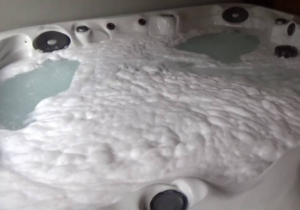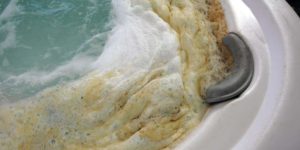Getting in your hot tub after a long, stressful day at work is the best way to unwind and rejuvenate. If you ever open your cover to find cloudiness, foaming, or waterline build up, it just needs a little more attention.
Cloudiness

When your spa becomes cloudy, it is usually a sign that the water chemistry is out of balance, the filter needs to be cleaned, or the filter just isn’t running long enough. If the chlorine is low, bacteria and mold can grow and multiply causing cloudiness. When the pH, alkalinity or hardness is high, it will cause cloudiness and scaling. To fix this, bring a water sample in to be tested. We will be able to tell you exactly what the cause is, if it is caused by water chemistry. If the water is balanced properly, then the filter could be dirty. Even if it looks clean when you take it out, the pleats can be clogged with oils preventing adequate filtration. Give your filters a chemical cleaning. Just rinsing the filter with water takes visible debris off the filter but does not remove greases and oils. Make sure to use a filter cleaner made for spas and to rinse it thoroughly until the water runs clear and is free of suds. You may also want to check the filter settings of your spa. If it is not running long enough then contaminants in the water are not being removed and they will accumulate causing the water to look cloudy. Contact us or the spa manufacturer for the recommended minimum filter run time.
Foaming

There are a few main causes of a hot tub foaming, including: detergents, beauty products, and water chemistry.
Detergents in bathing suits, fabric softener, or even a filter that wasn’t rinsed out enough can cause a lot of foaming. Beauty products like lotions, oils, make up and hair products can as well. If the water is chemically balanced, you can use an anti-foam product to fix the problem temporarily. The best way to avoid foaming is to shower before getting in to remove lotions and cosmetics from your skin, and use a product like a scum-bug to collect oils and soap residues in the water. You can also use an enzyme to help break down some of the contaminants causing the foaming. This also frees up the chlorine or bromine to do their job more efficiently, which means you won’t need to add as much of it. Natural Spa Enzyme and Spa Complete are two products that we carry that work very well. Make sure when you chemically clean your filter that you use a filter cleaner/degreaser made for spa filters. Rinse it thoroughly until the water is clear and free of suds.
Water chemistry- low calcium hardness can also promote foaming. Low chlorine can potentially promote foaming as well if there is a large build up of contaminants in the water. It is best any time you are having a problem with your spa to bring a sample of the water in to be tested. Don’t rely on test strips when there is a problem.
Water-line build up

Any kind of build up along the water line on the spa shell isn’t good. It’s unsightly and it eats up the sanitizer making it difficult to keep the spa water clean for bathers. It is usually caused by a build up of contaminants in the water such as body oils, biofilms and sometimes metals in the water. If you notice scum at the waterline, try a scum-bug to soak up some of the oils on the surface of the water. Also try using a spa enzyme product like Natural Spa Enzyme or Spa Complete. The enzymes will break up a lot of those contaminants so they don’t accumulate on the spa shell. It may also be time to drain and refill your spa. If you do, make sure to clean out the lines with System Flush to rid the plumbing of any bacteria or biofilm so you don’t have the same problem when you fill it back up.
Above all else, remember- if you’re having a problem with your spa water bring a water sample to your local BioGuard dealer. We are experts in our field and look forward to assisting you.




